You're using an outdated browser. Please upgrade to a modern browser for the best experience.
Please note this is a comparison between Version 1 by Ehsan Kamel and Version 2 by Vivi Li.
Urban building energy modeling (UBEM) is a practical approach in large-scale building energy modeling for stakeholders in the energy industry to predict energy use in the building sector under different design and retrofit scenarios. UBEM is a relatively new large-scale building energy modeling (BEM) approach which raises different challenges and requires more in-depth study to facilitate its application.
- urban building energy modeling
- physics-based
- bottom-up
- energy conservation measures
1. Introduction
Urban building energy modeling (UBEM) is a term used in the literature to refer to different types of simulations that are not necessarily related to the buildings in the “urban” area. Urban-scale, large-scale, and district-scale building energy modeling have been used in the literature interchangeably, but they all refer to the modeling and simulation of a group of buildings to study their energy use and behavior. The large-scale building energy modeling (herein UBEM) has been trending for the past decade (Figure 1) due to its effectiveness in providing a significant amount of data on a large group of buildings that could be used by different stakeholders in the energy sector such as energy policymakers, energy companies, building portfolio managers, and researchers. Making the modeling and simulation process more efficient in speed, flexibility, cost, and accuracy is critical, and this requires a thorough understanding of the current state of and future trends in UBEM tools and techniques.
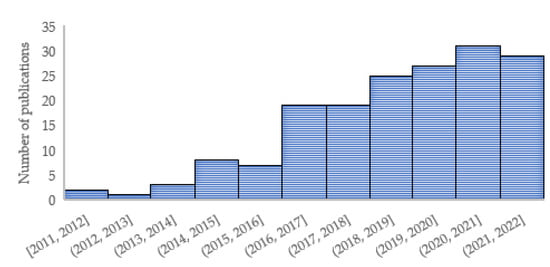
Figure 1.
The number of publications in physics-based urban building energy modeling per year since 2011 based on the Scopus search platform.
UBEM models are developed for different purposes, such as identifying the buildings with high energy use intensity (EUI), regions with high energy consumption, microclimate impact on building energy use, and studying the energy saving of different energy conservation measures (ECMs) on a large scale. Finding the most effective ECMs is one of the essential end goals in energy modeling projects; however, not all the UBEM approaches are suitable for this purpose. This highlights the importance of such systematic literature reviews.
In that context, it is necessary to understand the state-of-the-art physics-based UBEM methods and tools, especially those suitable for assessing different ECMs. Therefore, the objectives of this papentryr are defined as follows: (1) to perform a reproducible systematic review of the literature on research papers on physics-based UBEM case studies; (2) to extract, categorize, and analyze the tools, files schemas, data sources, building systems, and environmental data in these case studies, and (3) to find and categorize the existing challenges in physics-based UBEM and propose future research directions. The papers reviewed in this study either use a physic-based simulation engine or adopt similar types of inputs required for physics-based simulation that are or could be applied in ECM analysis.
2. UBEMLiterature Review
Physics-based UBEM could include multiple aspects and steps proposed by researchers such as data preprocessing (e.g., geometric data, non-geometric data, weather data, and energy use), model generation, simulation, calibration, and application (e.g., urban planning, stock-level carbon reduction, building-level recommendations, and building-to-grid integrations) [1][5]. Figure 23 proposes a five-step data extraction/presentation approach for UBEM studies. This data and metadata adoption structure help to take a systematic and standard practice to provide and collect data in UBEM projects.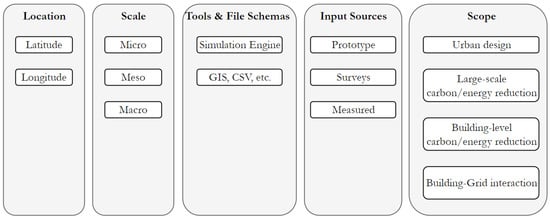
Figure 23.
Physics-based urban building energy modeling project definition, data, and metadata extraction approach and categories.
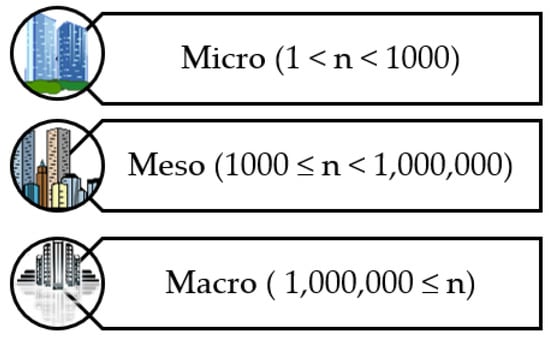
Figure 34.
Suggested scaling categories for urban building energy modeling.

Figure 45.
The frequency of the number of buildings simulated in physics-based urban building energy modeling case studies.
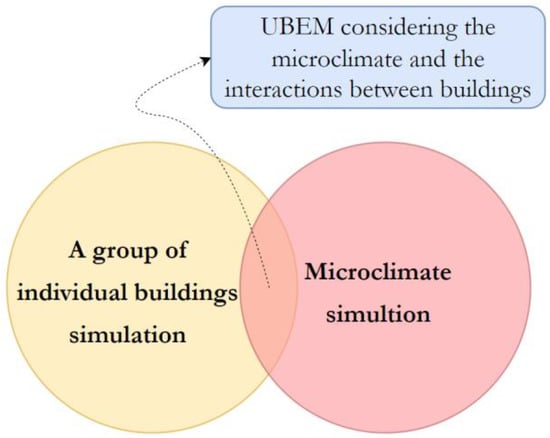
Figure 56.
Two distinct areas of study in urban building energy modeling.
Table 1.
Review studies on urban building energy modeling.

Figure 67.
Keywords with the highest use in urban building energy modeling research studies developed by VOSviewer.
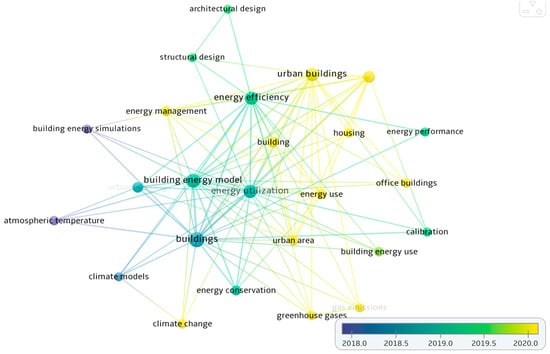
Figure 78.
The frequency of different keywords in urban building energy modeling studies before 2018 and after 2020 developed by VOSviewer.
3. Challenges in UBEM
Researchers have identified several challenges and shortcomings that slow down the application of UBEM and hinder it from achieving its full potential in the built environment. Figure 821 summarizes and categorizes these challenges. Ten distinguished groups list the lack of the following items:
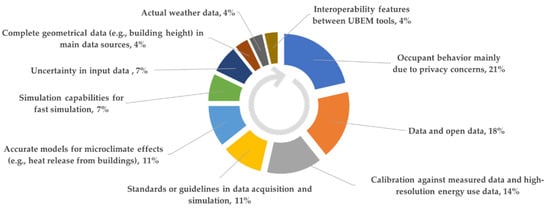

Figure 821.
Areas in physics-based urban building energy modeling with shortcomings identified by researchers.
| Reference | UBEM Research Area |
|---|---|
| General Review | |
| [9][13] | Advancing urban building energy modeling through new model components and applications |
| [10][14] | Bottom-up physics-based approaches in UBEM |
| [11][15] | Information modelling for urban building energy simulation |
| [12][16] | AUBEM modeling approaches and procedures |
| [13][17] | State-of-the-art and prospects in urban building energy modeling |
| [14][18] | Ten questions on urban building energy modeling |
| [15][19] | The nascent field of urban building energy modeling |
| [16][20] | UBEM methods and tools using qualitative and quantitative analysis |
| [1][5] | Use cases in urban building energy modeling |
| UBEM tools | |
| [17][21] | A comparison of available tools in urban building energy modeling |
| [18][22] | UBEM tools |
| [19][23] | UBEM tools for district-scale energy systems |
| Occupant-centric | |
| [20][24] | Approaches, inputs, and data sources in occupant-centric urban building energy modeling |
| [21][25] | Occupant behavior in urban building energy models |
| Data acquisition | |
| [22][26] | Data acquisition for urban building energy modeling |
| [23][27] | GIS Data Extraction and Visualization to Support Urban Building Energy Modeling |
| [24][28] | Infrared thermography in the built environment |
| Classification and archetype development | |
| [25][29] | Archetype development strategies for energy assessment at the urban scale |
| [26][30] | Developing a common approach for classifying building stock energy models |
| Energy conservation potentials | |
| [27][31] | Energy saving potential for large-scale building |
| [28][32] | Estimating the energy-saving potential in national building stocks |
| Accuracy and calibration | |
| [2][6] | Accuracy of Urban Building Energy Modeling |
